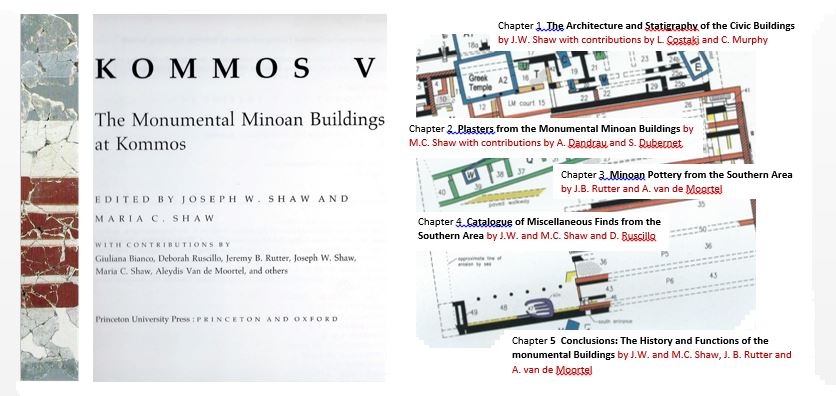A Review of “Kommos V”

Kommos V the Monumental Minoan Buildings at Kommos presents the southern area of the excavations which includes the monumental buildings found at the site. In addition to chapters written by the principle excavators at Kommos, Joseph and Maria Shaw (JS and MS henceforth), nine other authors contribute, with particularly extensive contributions on pottery by Jeremy Rutter (R) and Aleydis Van de Moortel (VdM). This is a massive work of over 1200 pages but the shear bulk of this volume is easily surpassed by its importance. In each of the several disciplines presented, the discussion moves beyond that of an excellent excavation and site report, which they all are, to placing the material and site into the broader context of the Mesara, Minoan Crete, and the Bronze Age eastern Mediterranean. Often in publications, a single chart or table offered as supporting evidence, is in itself of great import, for example John Traill’s map of Attic phylai. There are many in Kommos V: a table of Minoan stoas with pertinent dimensions, although not in chart form, a typology of flooring plasters, pictorial techniques for murals, approximate synchronization of ceramic phases at Phaistos, Kommos and Knossos, mammalian presence on Crete from the Pleistocene period to the present day, to cite a few. In short, as with the ceramic portion, this volume is a reference work not just for Kommos but Minoan studies in general.
Quibbles (These are only quibbles and do not in any way lessen the excellence of this work.)
Although certainly through no fault of the Shaws or their chief architectural illustrator Giuliana Bianco, the architectural drawings are not reproduced in a scalable form. The shrink to fit a page dictum may please publication editors but for anyone attempting architectural or spatial analyses, this is a frustration. It is not necessary to reproduce drawings at a 1:1 ratio but reductions should be in some meaningful and measurable percentage. The primary concern should not be to print the drawing(s) as large as possible within 1 x 1 x 1 x 1.5 inch margins.
Although the presentation of the ceramic evidence is outstanding and of great significance, it is so extensive it likely should have been a second volume, or Kommos V should have been a volume in two parts. Yes, there is value to have all the evidence for the monumental buildings bound together, but the sheer bulk of the work makes it ponderous to move back and forth from text to plates and drawings. Perhaps, as another alternative, these plates and drawings, nearly 300 pages worth, could have been a second fascicle. That way a reader could keep the relevant visual material before her or him while reading the text.
In sum, this is an extremely important work for many reasons, primary and secondary. Most importantly it documents the first known instance of a Minoan ship shed and moves forward the discussion and understanding of Minoan pottery. In addition, it provides a ready reference for many fields of Minoan and Cretan studies both major and “minor.”
Submitted by James C. Stratis
This is an excerpt of the Bryn Mawr Classical Review 2007.02.50 by Paul D. Scotton, California State University Long Beach (pscotton@csulb.edu)
You can follow us on Twitter (@KommosAP) or join us on Facebook (Kommos Conservancy).
“Μπορείτε να μας ακολουθήσετε στο Twitter (@KommosAP) ή στο Facebook (Kommos Conservancy).”

Leave a Reply
You must be logged in to post a comment.